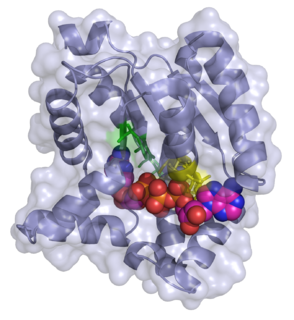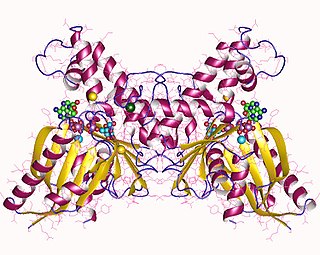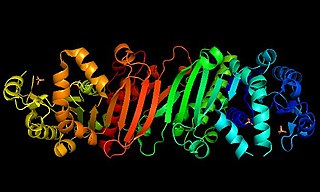Dikinases are a category of enzymes that catalyze the chemical reaction
- ATP + X + Y AMP + X-P + Y-P.
Dikinases are all phosphotransferases. Their designated EC number is 2.7.9. It is one of the smallest groups of phosphotransferases.
Dikinases are a category of enzymes that catalyze the chemical reaction
Dikinases are all phosphotransferases. Their designated EC number is 2.7.9. It is one of the smallest groups of phosphotransferases.
Dikinases take two phosphate groups from ATP and transfer each one to a different acceptor. This results in AMP and two different phosphorylated compounds. In most dikinases, one of the acceptors is water. In at least one dikinase (pyruvate, phosphate dikinase), one of the acceptors is inorganic phosphate, resulting in diphosphate.
For the dikinases that use water as acceptor, it has been shown that the γ-phosphate of ATP (the third, most distant phosphate) is transferred to water, whereas the β-phosphate (the middle phosphate) is transferred to the other acceptor. It has also been shown that the enzyme first phosphorylates itself (autophosphorylation). After transfer of the γ-phosphate to water, the β-phosphate is first transferred to a histidine residue on the enzyme, and later to the final acceptor.
Dikinases are commonly named as follows: first acceptor, second acceptor kinase. Examples:
Dikinases should not be confused with diphosphotransferases (EC 2.7.6), which are phosphotransferases which act upon pyrophosphate groups.
Phosphotransferases are a category of enzymes that catalyze phosphorylation reactions. The general form of the reactions they catalyze is:

In biochemistry, phosphorylases are enzymes that catalyze the addition of a phosphate group from an inorganic phosphate (phosphate+hydrogen) to an acceptor.

Adenylate kinase is a phosphotransferase enzyme that catalyzes the interconversion of the various adenosine phosphates. By constantly monitoring phosphate nucleotide levels inside the cell, ADK plays an important role in cellular energy homeostasis.

Nucleoside-diphosphate kinases are enzymes that catalyze the exchange of terminal phosphate between different nucleoside diphosphates (NDP) and triphosphates (NTP) in a reversible manner to produce nucleotide triphosphates. Many NDP serve as acceptor while NTP are donors of phosphate group. The general reaction via ping-pong mechanism is as follows: XDP + YTP ←→ XTP + YDP. NDPK activities maintain an equilibrium between the concentrations of different nucleoside triphosphates such as, for example, when guanosine triphosphate (GTP) produced in the citric acid (Krebs) cycle is converted to adenosine triphosphate (ATP). Other activities include cell proliferation, differentiation and development, signal transduction, G protein-coupled receptor, endocytosis, and gene expression.
In enzymology, a [acetyl-CoA carboxylase] kinase is an enzyme that catalyzes the chemical reaction
In enzymology, an alkylglycerol kinase is an enzyme that catalyzes the chemical reaction
In enzymology, a dephospho-CoA kinase is an enzyme that catalyzes the chemical reaction
In enzymology, a dihydrostreptomycin-6-phosphate 3'alpha-kinase is an enzyme that catalyzes the chemical reaction
In enzymology, a hamamelose kinase is an enzyme that catalyzes the chemical reaction

In enzymology, a N-acylmannosamine kinase is an enzyme that catalyzes the chemical reaction
In enzymology, a phosphoglucan, water dikinase (EC 2.7.9.5) is an enzyme that catalyzes the chemical reaction

Phosphoribulokinase (PRK) (EC 2.7.1.19) is an essential photosynthetic enzyme that catalyzes the ATP-dependent phosphorylation of ribulose 5-phosphate (RuP) into ribulose 1,5-bisphosphate (RuBP), both intermediates in the Calvin Cycle. Its main function is to regenerate RuBP, which is the initial substrate and CO2-acceptor molecule of the Calvin Cycle. PRK belongs to the family of transferase enzymes, specifically those transferring phosphorus-containing groups (phosphotransferases) to an alcohol group acceptor. Along with ribulose 1,5-bisphosphate carboxylase/oxygenase (RuBisCo), phosphoribulokinase is unique to the Calvin Cycle. Therefore, PRK activity often determines the metabolic rate in organisms for which carbon fixation is key to survival. Much initial work on PRK was done with spinach leaf extracts in the 1950s; subsequent studies of PRK in other photosynthetic prokaryotic and eukaryotic organisms have followed. The possibility that PRK might exist was first recognized by Weissbach et al. in 1954; for example, the group noted that carbon dioxide fixation in crude spinach extracts was enhanced by the addition of ATP. The first purification of PRK was conducted by Hurwitz and colleagues in 1956.
ATP + Mg2+ - D-ribulose 5-phosphate ADP + D-ribulose 1,5-bisphosphate
In enzymology, a pseudouridine kinase is an enzyme that catalyzes the chemical reaction

Pyruvate, phosphate dikinase, or PPDK is an enzyme in the family of transferases that catalyzes the chemical reaction
In enzymology, a pyruvate, water dikinase (EC 2.7.9.2) is an enzyme that catalyzes the chemical reaction
In enzymology, a selenide, water dikinase (EC 2.7.9.3) is an enzyme that catalyzes the chemical reaction
In enzymology, a streptomycin 3"-kinase is an enzyme that catalyzes the chemical reaction
In enzymology, a streptomycin 6-kinase is an enzyme that catalyzes the chemical reaction
In enzymology, a tagatose kinase is an enzyme that catalyzes the chemical reaction
In enzymology, a thiamine kinase is an enzyme that catalyzes the chemical reaction